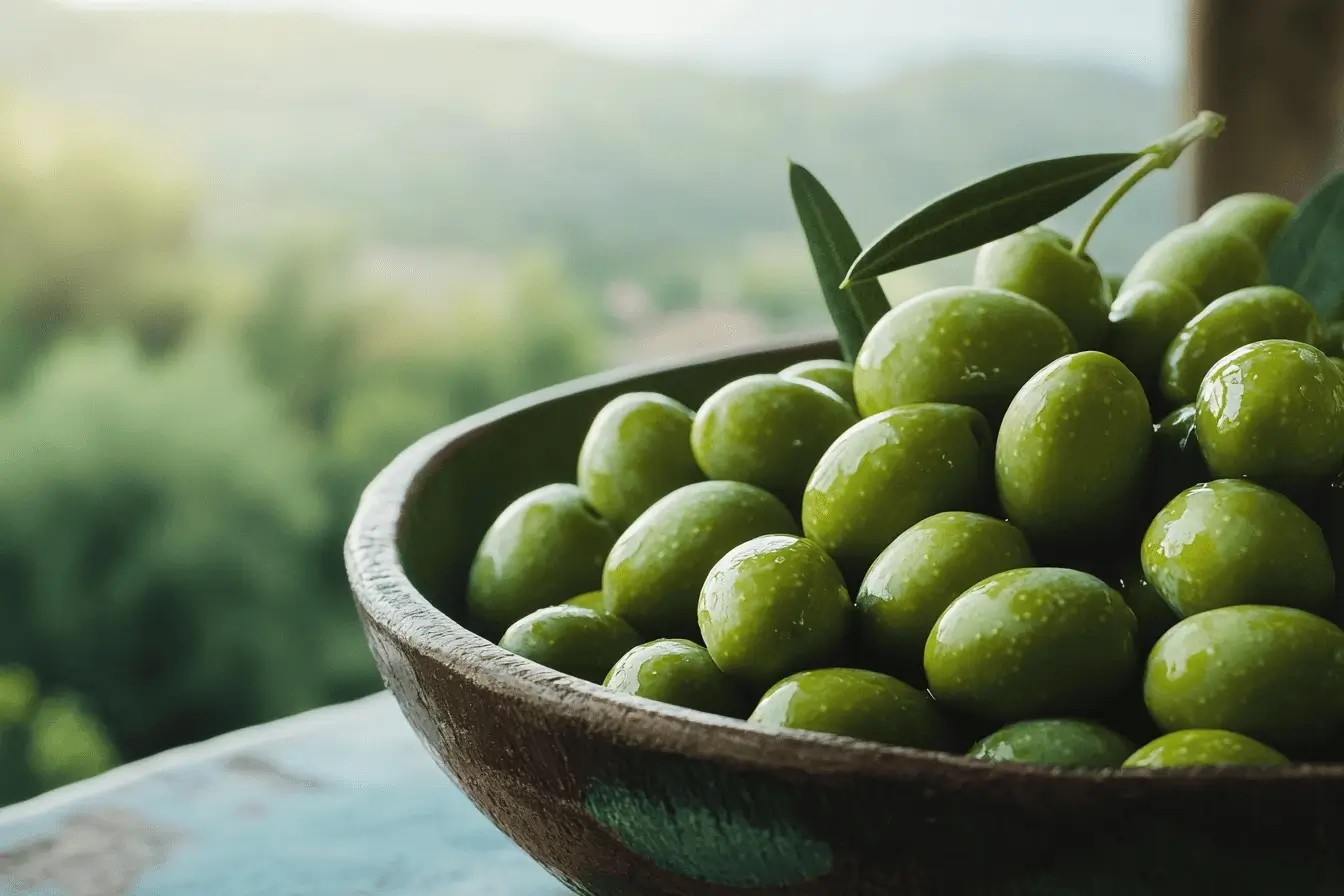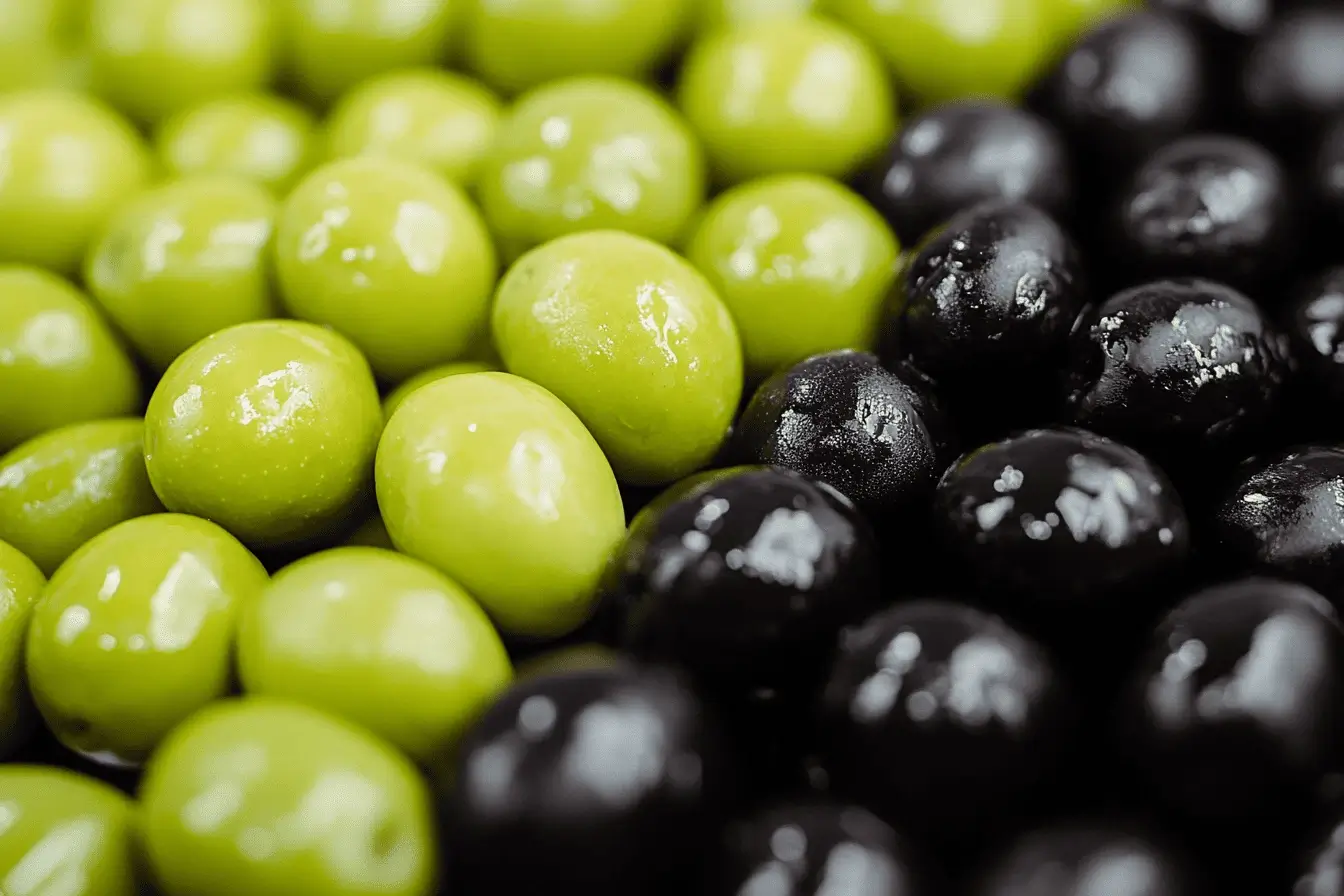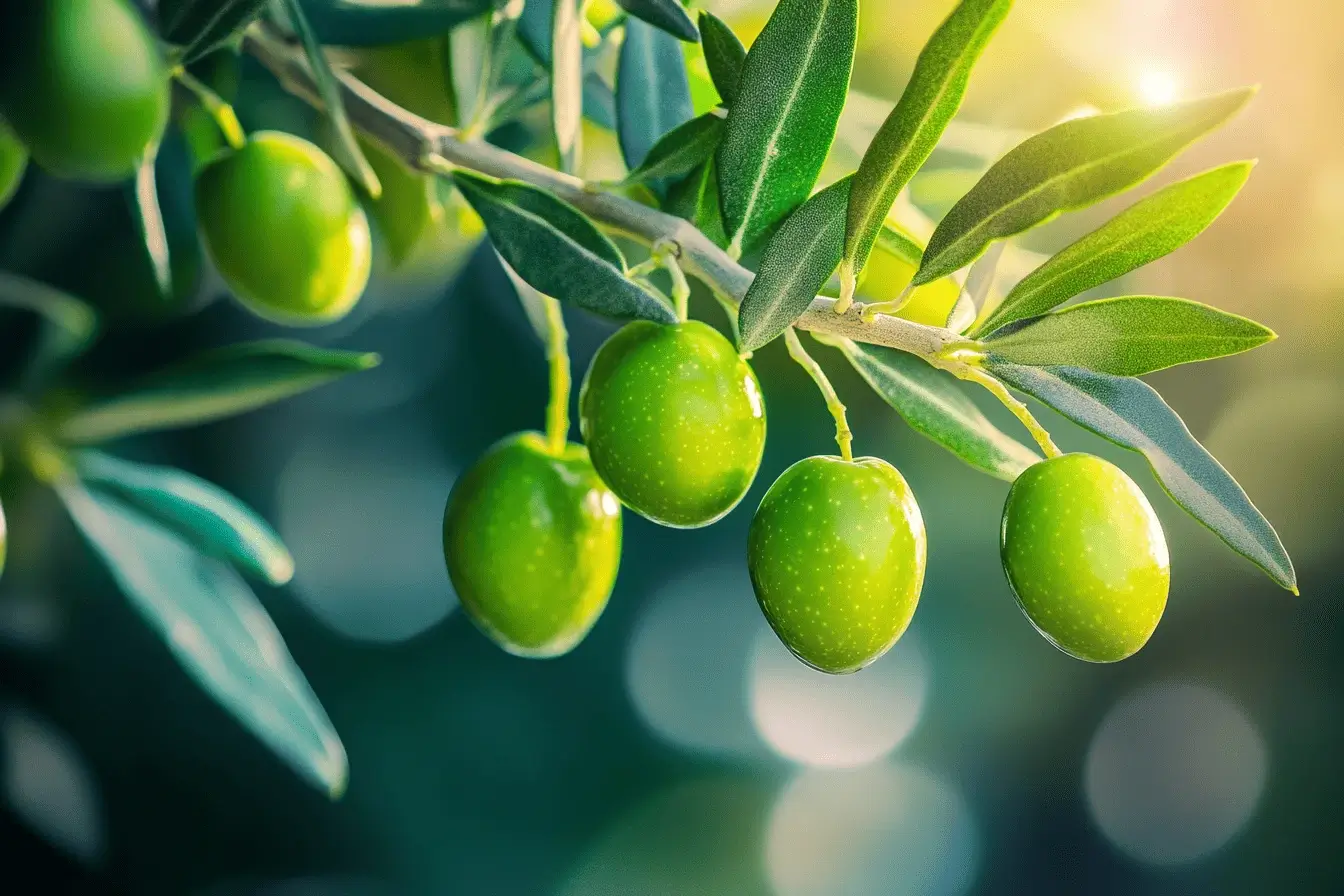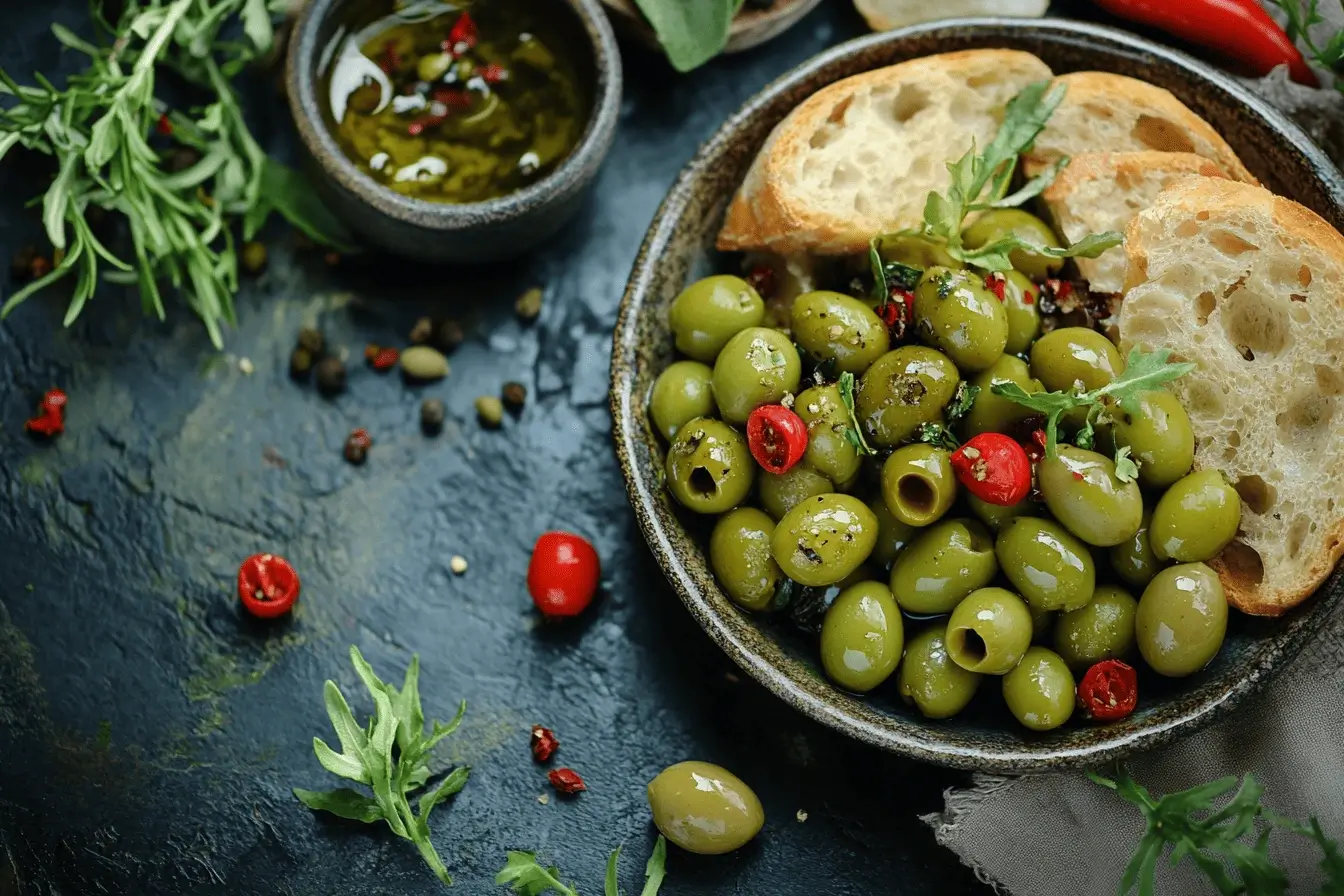Introduction: The Curiosity Behind Green and Black Olives
Olives have long been a staple of Mediterranean diets, enjoyed in various forms around the world. Their distinct flavors, textures, and nutritional value have made them a beloved ingredient in many kitchens. However, a question often arises: Are green olives just unripe olives? This seemingly simple query has intrigued food enthusiasts and home cooks alike for years.
As we dive into the differences between green and black olives, it’s important to address the widespread confusion. Many assume that the color difference is just a matter of ripeness, but the truth is more nuanced. Unripe green olives and fully ripened black olives go through different harvesting and curing processes, which greatly influence their final taste and texture. Understanding this distinction can enhance your appreciation for these little fruits, whether you’re adding them to a salad, pasta, or enjoying them on their own.
In this article, we’ll explore the olive ripening process, the various types of olives, and how their color affects their culinary uses. So, let’s answer that burning question: Are green olives just unripe olives? We are about to reveal the full truth.
What Exactly Are Olives? A Brief Overview
What Are Olives?
At their core, olives are fruits—small, oval-shaped fruits that grow on the olive tree, scientifically known as Olea europaea. Native to the Mediterranean region, olives have been a cornerstone of the local diet for thousands of years. In fact, archaeological evidence suggests that people cultivated olives as early as 3,000 B.C. Today, farmers grow them not just in the Mediterranean but also in parts of the United States, South America, and Australia, making them a truly global food.
Though we often associate olives with savory dishes, it’s worth remembering that olives are classified as stone fruits, just like peaches or cherries. They contain a pit or “stone” at the center, surrounded by a fleshy exterior. Green olives dinner recipes can offer innovative ways to add these fruits to your meals, complementing their unique flavors.
A Look at Olive Varieties
Olives come in a surprising range of varieties, each with its own flavor profile and culinary uses. While black and green olives are the two most common types, the olive family extends far beyond these familiar categories. For instance, you’ve probably heard of popular varieties like Kalamata, which offer a rich, fruity taste, or Castelvetrano olives, which people often praise for their mild flavor and meaty texture. These varieties differ not only in their origins but also in how harvesters, curers, and processors treat them.
Interestingly, most olives—whether green or black—start out on the same tree. The color, flavor, and texture of olives evolve depending on when harvesters pick them and how they treat them afterward. This brings us back to our core question: Are green olives just unripe olives? Stay tuned, as we’re about to dive deeper into the differences between green and black olives.
Green vs. Black Olives: Visual and Taste Differences
How to Differentiate Green and Black Olives
At first glance, the difference between green and black olives seems obvious: their color. However, this color variation isn’t just cosmetic; it signifies different stages of ripeness and distinct flavor profiles. Harvesters pick green olives early, while they are still unripe, giving them their characteristic firm texture and slightly bitter taste. Are green olives good for you? dives deeper into the health benefits of these bitter but nutritious fruits.
Black olives tend to appear softer and wrinkled, especially if people dry-cure them. Green olives, in contrast, are smoother, firmer, and often have a brighter, glossier surface. But color isn’t the only distinction—size and shape can also vary between varieties. For instance, the Kalamata olive is dark purple and almond-shaped, while the Manzanilla green olive is round and small.
Taste and Texture Differences Between Green and Black Olives
The difference in ripeness affects not just the look of the olive but also its taste and texture. Green olives tend to be firmer and have a sharper, more bitter flavor. Phenolics, compounds naturally present in unripe olives, cause this bitterness. Over time, as the olive ripens and turns black, these compounds diminish, resulting in a smoother, milder flavor.
People often describe green olives as crisp and meaty, offering a satisfying bite. In contrast, black olives, especially those brined or cured for longer periods, usually feel softer and have a more mellow flavor profile. This quality makes them popular in dishes where a subtle olive flavor is preferred, such as tapenades or Mediterranean salads.
The Olive Ripening Process Explained
What Happens During Olive Ripening?
The transformation of olives from green to black is a fascinating process that involves both natural and man-made factors. Olives start as small, hard, green fruits packed with bitter compounds. Which olives are healthier, green or black? can help in choosing the best option depending on your taste preferences and nutritional goals.
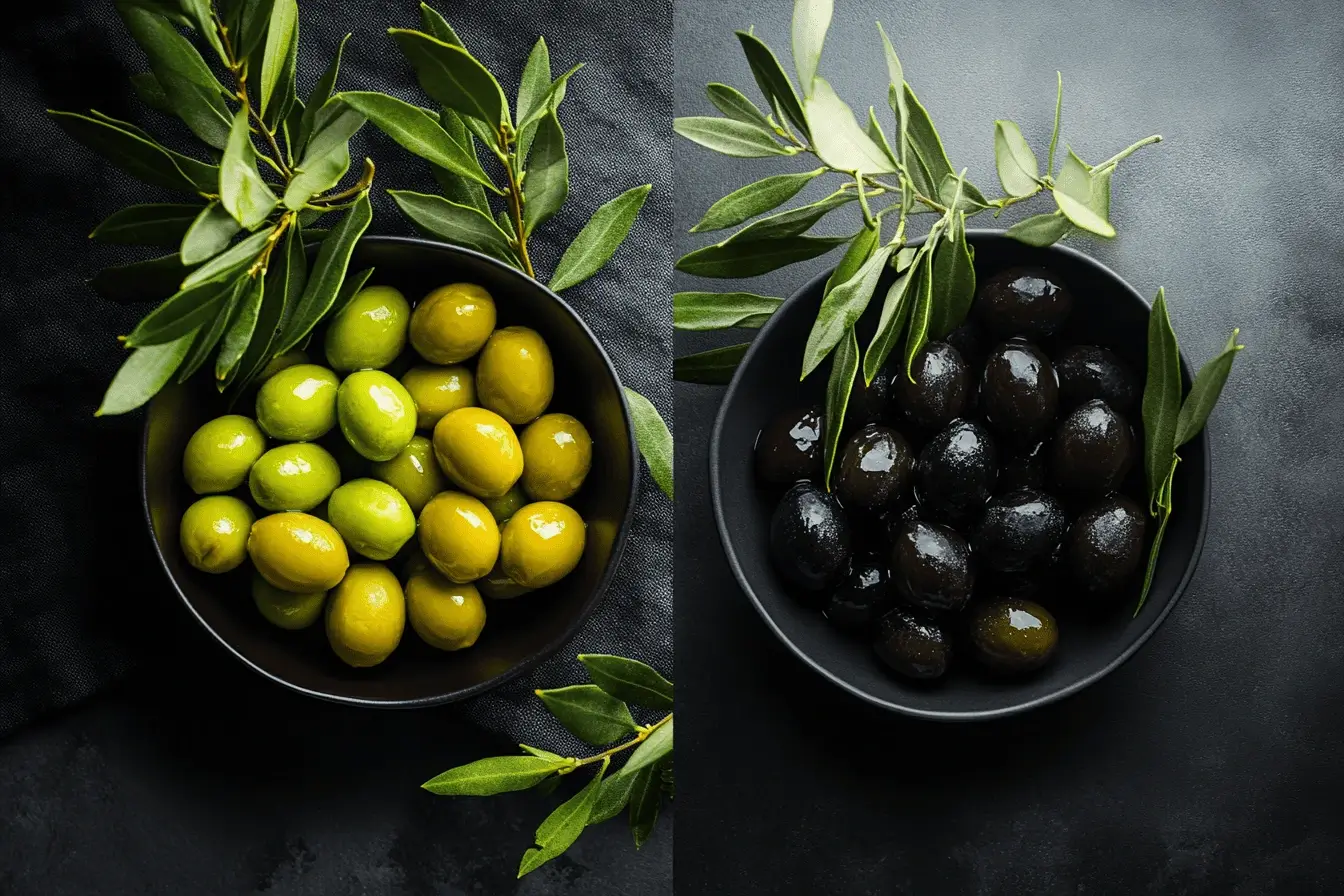
Ripening also alters the olive’s internal chemistry. Early in the ripening process, olives contain high levels of polyphenols, which are responsible for their bitter taste. As the fruit ripens, these polyphenols break down, resulting in a milder, less bitter flavor. Additionally, the olive’s oil content increases as it ripens, making black olives richer and more flavorful compared to their green counterparts.
Harvesting Green vs. Black Olives
The timing of the olive harvest crucially determines whether people process the fruit as green or black olives. Harvesters pick green olives early in the season, usually in late summer or early fall, while they are still firm and unripe. Harvesting at this stage preserves their distinct bitterness and crisp texture. On the other hand, they leave black olives on the tree to ripen, often until late fall or winter. By this point, they have softened and developed a darker color, making them less bitter and more oil-rich.
Are Green Olives Just Unripe Olives? Answering the Core Question
Yes, But There’s More to the Story
So, are green olives just unripe olives? The simple answer is yes green olives are indeed olives that people pick before they fully ripen. However, there’s much more to the story than just ripeness. The distinction between green and black olives isn’t purely a matter of time spent on the tree. The way people harvest, cure, and process the olives plays an equally significant role in determining their final flavor, texture, and appearance.
Why Timing Matters: Harvesting at Different Stages
While all olives start out green, people don’t leave all black olives on the tree to fully ripen. The timing of the harvest is crucial and influences both the flavor and nutritional content of the olives. Early-harvest olives, picked when still green, are firmer and more bitter, but also tend to have a higher concentration of polyphenols—natural compounds that offer health benefits like anti-inflammatory properties.
In short, green olives are unripe, but that’s only part of the equation. The timing of the harvest, combined with how people cure and process the olives, ultimately shapes their unique characteristics.
How Curing and Processing Affect Olive Taste
The Art of Curing Olives: Salt, Brine, and More
Once people harvest olives—whether green or black—they must undergo a crucial transformation process known as curing. This is because fresh olives are almost inedible due to their high concentration of bitter compounds. Curing helps to mellow out the bitterness and develop the flavors that make olives so enjoyable.
Brining is one of the most common methods for both green and black olives. In this process, people submerge olives in a saltwater solution for several weeks or even months. The saltwater gradually draws out the bitterness while enhancing the natural flavors of the olives. This method is particularly common for green olives.
Dry curing is another method, typically used for black olives. In this process, people pack olives in salt, which slowly extracts moisture and bitterness over time. Dry-cured olives tend to have a more wrinkled appearance and a denser, more intense flavor.
How Curing Changes Olive Flavors and Textures
The curing process not only removes the bitterness from olives but also imparts a range of flavors, depending on the method used. Brined green olives, for example, often take on a sharp, salty taste, while retaining a firm, crisp texture. On the other hand, dry-cured black olives develop a rich, concentrated flavor, with a chewy, almost leathery texture that pairs well with hearty Mediterranean dishes.
Nutritional Benefits of Green and Black Olives
Nutritional Comparison: Green vs. Black Olives
When comparing green and black olives, it’s important to note that while both types share many health benefits, there are subtle differences in their nutritional profiles. Olives, regardless of their color, provide an excellent source of heart-healthy fats, particularly monounsaturated fats, which support cardiovascular health.
Since people harvest green olives earlier, they tend to have fewer calories and slightly higher levels of sodium due to the brining process.
Antioxidants, Healthy Fats, and Vitamins
One of the standout nutritional features of both green and black olives is their high content of antioxidants. These antioxidants, including polyphenols and flavonoids, help protect the body’s cells from oxidative stress, reducing the risk of chronic diseases. In fact, a balanced diet that includes olives might also help How many olives should I eat a day? as part of a healthy lifestyle plan.
In summary, whether you prefer green or black olives, both types offer a wealth of nutritional benefits.
Using Green and Black Olives in Cooking
How to Use Green and Black Olives in Your Dishes
Olives are a versatile ingredient that can enhance a wide range of dishes with their bold flavors and unique textures. Whether you’re preparing a hearty salad, a savory stew, or even a charcuterie board, knowing how to use green and black olives effectively can elevate your cooking. For example, olives bring out the depth of flavor in Easy creamy chicken potato soup, offering a briny contrast to the creaminess.
Green olives, with their sharper, more tangy taste, are often used to add a briny kick to dishes. Black olives, by contrast, are milder and slightly sweeter, making them a great addition to recipes where a subtler olive flavor is preferred.
Versatile Ways to Include Olives in Your Meals
Here are some creative ways to incorporate olives into your meals:
- Salads: Add green or black olives to Mediterranean or Greek salads for a burst of flavor.
- Pasta: Toss black olives into pasta dishes with olive oil, garlic, and herbs.
- Tapenade: Blend black olives with capers, garlic, and olive oil to make a rich tapenade.
- Pizza: Sprinkle sliced green or black olives on top of pizzas for a savory, briny kick.
Popular Olive Varieties and Their Unique Traits
Exploring Famous Olive Varieties
While the basic distinction between green and black olives is widely known, the world of olives extends far beyond just these two categories. Olives come in many varieties, each with its own unique flavor profile, size, and ideal culinary uses.
One of the most well-known varieties is the Kalamata olive, a large, dark purple olive hailing from Greece. Another favorite is the Castelvetrano olive, a bright green olive from Sicily. Castelvetrano olives are milder and less bitter than other green varieties, with a buttery texture and sweet flavor.
From Kalamata to Castelvetrano: What Makes Them Special?
Here’s a quick rundown of some popular olive varieties and what sets them apart:
- Kalamata: Known for their dark purple color and almond shape.
- Castelvetrano: Bright green with a mild, buttery taste.
- Manzanilla: A small, green Spanish olive, often stuffed with pimentos or garlic.
- Niçoise: Small, dark olives from France, with a bold flavor.
Conclusion: Are Green Olives Just Unripe Olives? Yes, But…
Final Thoughts on the Green vs. Black Olive Debate
So, are green olives just unripe olives? The answer is yes, but as we’ve explored, there’s much more to it than simply ripeness. Green olives are harvested early, while black olives are left to mature longer on the tree. The result is two distinct types of olives, each with its own flavor, texture, and uses.
Choose Based on Your Taste and Needs
At the end of the day, the choice between green and black olives comes down to personal preference. Both olives bring their own unique set of flavors and health benefits to the table. Next time you’re shopping for olives, don’t hesitate to experiment with different varieties!


